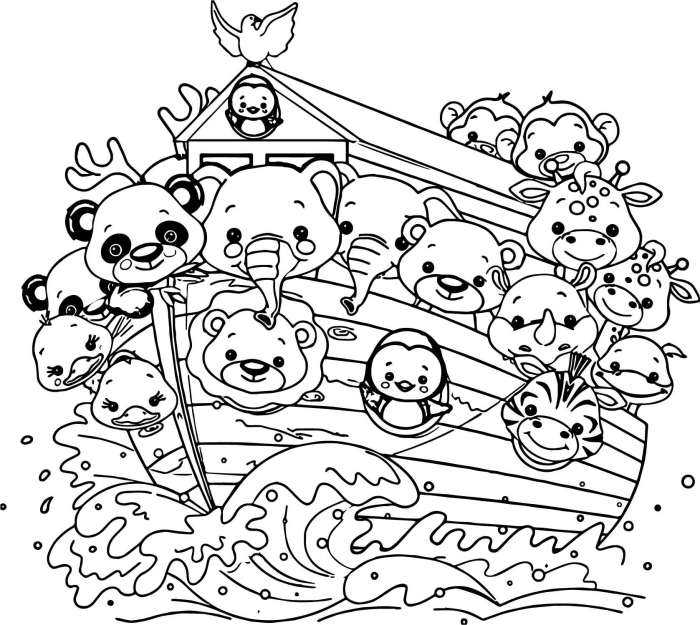Production & Publishing: Coloring Book Pages Of Noah’s Ark

Coloring book pages of noah’s ark – Bringing your Noah’s Ark coloring book to life involves a careful process encompassing file preparation, paper selection, printing, binding, and copyright considerations. Each step contributes to the final product’s quality and marketability. This section Artikels the key stages involved in transforming your artwork into a tangible coloring book.
Creating a Print-Ready File, Coloring book pages of noah’s ark
Preparing a print-ready file requires attention to detail and adherence to specific specifications. The artwork should be high-resolution (at least 300 DPI) to ensure crisp, clear images when printed. All pages must be sized correctly according to the chosen trim size (the final size of the book). Color profiles should be consistent throughout the document, ideally using CMYK for print.
The file should be saved in a format suitable for professional printing, such as PDF/X-1a. Software like Adobe Illustrator or InDesign are commonly used for this purpose, allowing for precise control over layout and color management. Bleed (extra space around the artwork) should be added to account for minor shifts during printing and trimming. Finally, a thorough proofread is essential to catch any errors before printing.
Paper Types for Coloring Books
The choice of paper significantly impacts the coloring experience. Heavier weight paper (at least 80lb or 118gsm) is preferred to prevent bleed-through from markers or colored pencils. Options include:
- Cardstock: A thicker, more durable paper ideal for resisting tearing and handling repeated use. It provides a crisp surface for detailed coloring.
- Drawing paper: Offers a slightly textured surface, providing good tooth for various coloring media. It’s usually lighter weight than cardstock but still suitable for many coloring techniques.
- Specialty paper: Some papers are specifically designed for coloring, offering features like a smooth surface for markers or a textured surface for pencils. These often come with a higher price tag.
The paper’s brightness and whiteness also influence the vibrancy of colors. A brighter paper generally produces more vivid results.
Printing and Binding Options
Several printing and binding options are available, each with advantages and disadvantages:
- Offset Printing: Suitable for large print runs, offering high-quality results at a competitive cost per unit. It involves transferring ink from plates to the paper using a press.
- Digital Printing: Ideal for smaller print runs, offering flexibility and faster turnaround times. It’s generally more expensive per unit than offset printing for larger quantities.
- Binding Options: Saddle stitch binding (stapling) is common for smaller coloring books, while perfect binding (gluing pages together) is suitable for larger, thicker books. Wire-O binding provides a professional look and allows the book to lay flat.
The choice depends on the print run size, budget, and desired aesthetic.
Copyright Permissions
If your coloring book includes images or text that you do not own the copyright to, you must obtain permission from the copyright holder before publishing. This usually involves contacting the copyright holder (often through their publisher or agent) and requesting permission to use their material. You’ll likely need to negotiate a licensing agreement that Artikels the terms of use, including payment and usage rights.
Failure to obtain permission can lead to legal action.
Self-Publishing Steps
Self-publishing offers control over the entire process, but it requires careful planning and execution. The steps include:
- Prepare your files: Ensure your files meet the specifications of your chosen printer.
- Choose a printer: Research and select a printer based on your budget, print run size, and desired quality.
- Order your print run: Place your order with the printer, specifying the paper type, binding, and quantity.
- Design your cover: Create an eye-catching cover design that will attract potential buyers.
- Obtain an ISBN: An ISBN (International Standard Book Number) is necessary for distribution through many retailers.
- Set up distribution: Decide how you will distribute your book, such as through online retailers (Amazon, Etsy), local bookstores, or your own website.
- Market your book: Promote your coloring book through social media, online advertising, and other marketing channels.
Thorough research and planning are crucial for a successful self-publishing venture.
Coloring book pages depicting Noah’s Ark offer a fun and engaging activity for children. These pages often feature simplified drawings of the animals, making them ideal for younger artists. For even more simple designs, you might want to explore other options like those found on websites dedicated to books coloring easy pages , which offer a wide variety of themes.
Returning to Noah’s Ark, the detailed scenes can also provide a great opportunity to discuss the biblical story with children while they color.
